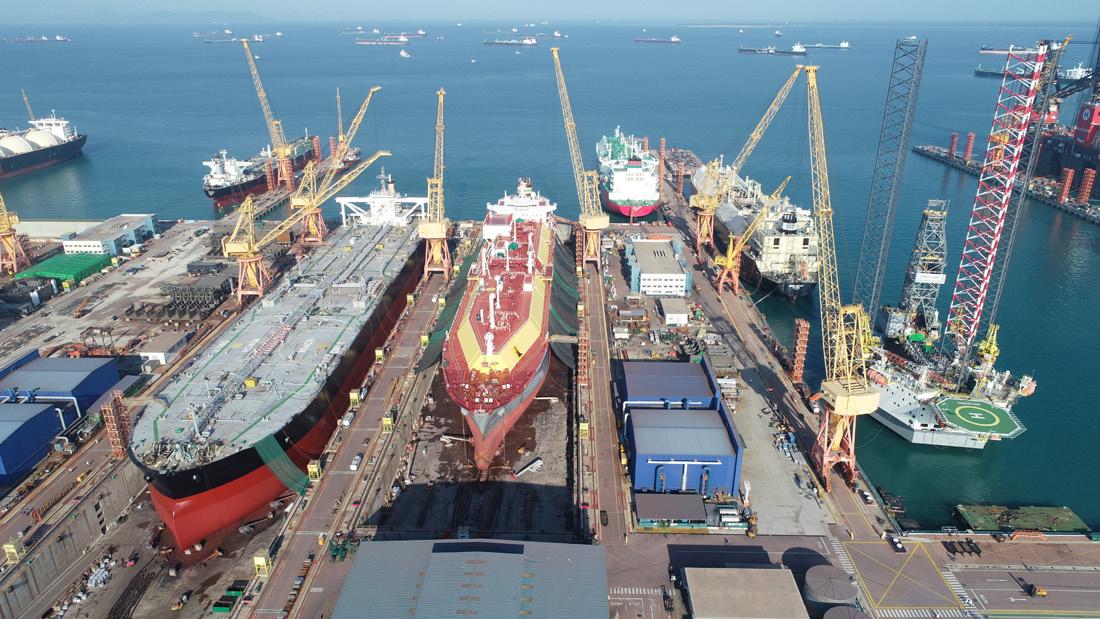South East Asia Keppel/Sembcorp Marine merger given the go-ahead It has now been almost a year since it was announced that Singapore’s two largest shipyard companies, Keppel Corporation and Sembcorp Marine, are to merge creating one of the largest facilities builders in the world with a value of S$9.42bn (US$6.8bn). The proposed combination follows the signing of a memorandum of understanding between Keppel and Sembcorp Marine during June 2021. This announcement of the merger will be put to shareholders later this year (2022). There are no details as to when the merger will actually take place. The main point of the merger is said to involve the offshore oil & gas industries, offshore renewables, new energy and cleaner O&M solutions. However, it will also involve the shiprepair and conversion industries. Sembcorp Marine is coming to the end of its lease on the Sembawang Shipyard and, with this in mind, has built a mega yard in Tuas (Tuas Boulevard Yard), having closed shiprepair activities in the former Jurong Shipyard facilities in Tanjong Kling and Pulau Sumulun. Meanwhile, Keppel operates yards in Tuas and Benoi. No information has yet been released as to what yards will remain open after the merger is completed. Both companies are controlled by Singapore-based global investment firm Temasek, which is part of the Singapore Government. Upon completion of the transaction, Keppel will own 56% of the combined entity, while Sembcorp will own 44%. Temasek will hold a 33.5% stake in the combined company. As part of the agreement, Keppel O&M will divest its legacy oil rigs business into a separate entity that will be owned by investors including Keppel Corp. and a unit of Temasek. “The signing of a win-win agreement on the proposed combination of Keppel O&M and Sembcorp Marine marks a strategic milestone for the offshore & marine sector,” said Loh Chin Hua, chief executive of Keppel and chairman of Keppel O&M. “It brings together two leading O&M companies in Singapore to create a stronger player that can realise synergies and compete more effectively amidst the energy transition. Together with the resolution of Keppel O&M’s legacy rigs, this is a major step forward in Keppel’s Vision 2030 journey, as we simplify our business and sharpen our focus on providing solutions for sustainable urbanisation.” The O&M sector has faced a severe downturn since 2015, exacerbated
An Aerial view of Sembcorp Marine’s Tuas Boulevard Yard
by the rapid global transition toward renewables and clean energy, as well as significant disruptions during the COVID-19 pandemic. Amid this downturn, competition has increased for a shrinking pool of projects, leading to increased debt across the industry and equity issuances to strengthen financial positions. The companies suffered a combined net loss of S$1.3bn ($942m) in 2021. The combined entity will adopt a new name and brand identity to reflect its focus on offshore renewables, new energy, and cleaner solutions in the O&M sector. This is a major move, which will obviously affect the shiprepair and conversion industries. Looking back into Singapore’s shiprepair industry, the eighties saw a number of large yards operating in these industries – Sembawang, Keppel, Jurong Shipyard, Mitsubishi and Hitachi Zosen. Other yards, such as Pan United and ST Marine, operate in the smaller ship market. However, through a series of buyouts and amalgamations, this was reduced to just two – Keppel and Sembcorp Marine. Sembawang and Jurong combined (and built a new mega yard in Tuas) to form Sembcorp Marine, and Keppel took over the Mitsubishi and Hitachi yards. So, now this will be reduced again to a single entity. What the current yards’ client base will feel about this move is far from clear. One main fact that has dominated the market in Singapore has been the fierce competition between Keppel and Sembcorp, despite both companies being part of the same holding company. This competition will disappear when it all becomes one entity – which many owners/managers may not be comfortable with. Both Keppel and Sembcorp Marine compete in the general shiprepair market, especially the repair of LNG tankers, and both compete in the FPSO/FSO/FSRU/FLNG markets Obviously, Singapore has rival companies/areas in the shiprepair and conversion markets – mainly in Malaysia and China (where there are a number of yards operating in these industries). Shipowners/managers will have that choice. It will be interesting in the coming years (short term) to see how the market reacts to this amalgamation move!
Greek ships in Far East yards Keppel’s Tuas yard during April this year
Within the last few days, numerous cities in China have posed strict restrictions and even lockdowns to stop the increase of COVID-19 cases due to the omicron variant. In the coming days, it will be seen if the Chinese government will manage to reduce COVID-19 cases in China
Volume 20 Issue 1 – Page 57












